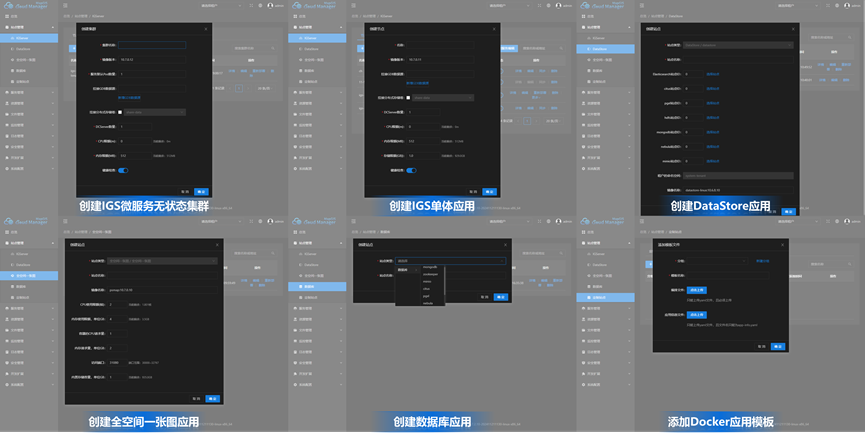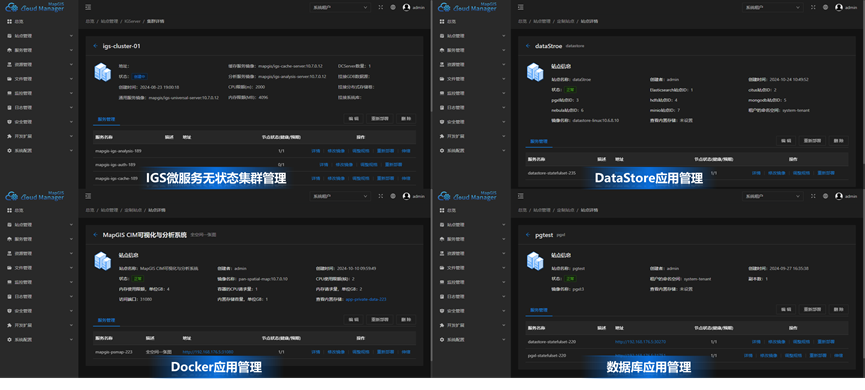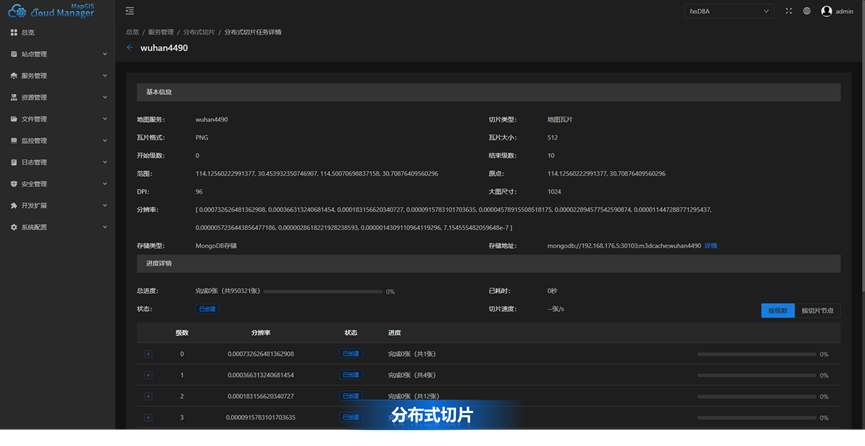
Cloud GIS
For cloud GIS application scenarios, we provide comprehensive product support covering different aspects of cloud GIS, including cloud GIS storage, cloud GIS servers, cloud operation and maintenance management, and cloud GIS applications.
MapGIS Cloud Manager seamlessly integrates with virtualization and containerization platforms to achieve unified management and operation of multiple resources. It adopts a tenant mechanism to achieve "hierarchical management and separate maintenance" of cloud GIS resources, providing professional and concise one-stop operation and maintenance management services.

Adaptation to cloud native GIS environment
●Supports mainstream CPU architectures and domestic chip platforms, including X86, ARM, MIPS, Alpha, LoongArch64, as well as domestic chips such as Feiteng, Kunpeng, Loongson, Shenwei, Zhaoxin, and Haiguang
●Supports commonly used Linux operating systems both domestically and internationally, such as RedHat, CentOS, Ubuntu, UOS, Zhongbiao Kirin, Galaxy Kirin, Deeptech, Euler, Zhongke Fangde, Wanli Hong, Hongqi, as well as Windows systems
●Support multiple domestic and international cloud platforms such as Huawei and Kubernetes

Cloud native microservice governance
●Building a unified microservice governance center based on cloud native architecture, providing finer grained microservice management capabilities
●Provide GIS microservices for automated deployment, flexible scaling, and maintenance monitoring
●Supports Kubernetes-based container automation orchestration, providing automated container management operations such as deployment, management, and expansion
●Supports one-click creation of various GIS sites such as MapGIS IGServer site, MapGIS DataStore site, cloud portal, one map site in all space
●Supports one-click creation of distributed storage sites such as MongoDB, ZooKeeper, MinIo, Citus, PostgreSQL-XL, Nebula, HDFS, ElasticSearch
●Supports one-click deployment of custom containerized applications, by reading the application's Yaml file container arrangement information and application information, to realize the automated deployment of containerized applications, resource docking, adjusting specifications, scaling, etc.
●Supports one-click deployment of MapGIS IGServer microservices clusters, providing microservice-level view details, modifying mirrors, adjusting specifications, redeploying, dynamic scaling, log viewing, command line and other functional operations

●Support cloud native monitoring, capable of monitoring K8s resources (memory, CPU, Pod, Service, etc.), node resources, tenant resources, MongoDB, PostgreSQL, JVM, URL, GIS microservice instances, and other resources. Use statistical charts to display real-time and historical resource usage, analyze the health status of the environment based on resource occupancy, and provide timely alarm prompts
●Provide Helm package for cloud management, supporting Helm deployment
Multi tenant collaboration and resource isolation
●Implementing refined management of organizational structure based on multi tenant mechanism
●Use hierarchical permissions to isolate, allocate, and audit resources such as underlying hardware, GIS operations, and feature menus
●Supports a full range of security mechanisms and log systems for more sophisticated management

Intelligent cluster management
●Supports on-demand creation of IGServer monobody stateless clusters and IGServer microservices stateless clusters
●Supports elastic scaling, to achieve GIS microservices elastic scaling by monitoring CPU, memory and other resource utilization
●Supports service synchronization and load balancing between cluster nodes
●Support microservice instance unified operation management, provide detailed view, modify mirroring, redeploy, specification adjustment, elastic scaling, resource monitoring, delete reconstruction, command line, delete and other operations, can be operated on demand to specify microservices, without affecting the entire cluster, provide a more stable cluster environment
●Supports a full range of microservice instance monitoring, including microservice instance CPU usage, memory usage, network reception, network sending, real-time network traffic, CPU quota, memory quota and other metrics to help operations and maintenance managers control cluster health

Integrated Resource Management
●Support unified storage, separate computing and storage, achieve resource isolation, and can scale independently for resources, including distributed shared storage, cloud managed local storage, application exclusive private storage, database storage, and other modes

●Provide comprehensive site management functions, which can manage various GIS site resources and industry application resources such as MapGIS IGServer site, MapGIS DataStore site, cloud portal, full space one map site, various databases, custom Docker custom applications, etc

●Provide unified management of various service resources such as map services, functional services, and extension services, as well as GIS service management functions such as service instance publishing and distributed slicing task management


●Provide functions such as service registration, service aggregation, and service publishing to achieve unified management of multiple service resources
●Provide functions such as data dictionary, metadata management, and resource directory management to achieve automatic cataloging of cloud resources and automatic construction of multi-level resource directory trees

High performance map service
●Supports high-performance vector map services through technologies such as multi-level indexing and dynamic rendering to release high-performance vector map services in a slice-free manner, enabling high concurrent second-level browsing and instant updates
●Based on distributed database to store tile data, support multi-machine distributed parallel cutting, improve tile cutting performance by adjusting the number of IGS computing nodes

One stop operation and maintenance monitoring
●Supports visual monitoring management interface to monitor service resources and software and hardware operation by means of dashboards, statistical charts, etc.
●Integrated GPE framework, support monitoring alarm and statistical analysis, etc., operation and maintenance management is more convenient
●Supports cloud native monitoring, including K8s as a whole, cluster nodes, microservice instances, tenants, Pods and other resources, analyzing the health of the environment by monitoring CPU, memory, storage and other real-time use of these resources
●Comprehensively integrated with the open source Prometheus ecosystem, offering a variety of component monitoring, out-of-the box preset monitoring drives, and fully hosted Prometheus services
●Supports site resource monitoring created or registered by MapGIS Cloud Manager, including resource monitoring for IGS single application nodes, IGS microservices stateless clusters, custom host resources, database hosts, custom URLs, etc.

●Support monitoring of databases such as MongoDB and PostgreSQL

●By utilizing K8s to provide infrastructure monitoring functionality, the main focus is on monitoring the usage of K8s resources (memory, CPU, Pod, Service, etc.), microservice clusters, node resources, tenant resources, MongoDB, PostgreSQL, JVM, URL, GIS microservice instances, and other resources

●Provide multiple business indicator monitoring, support the collection and visualization display of indicators such as GIS resources, GIS service instances, and online users

●Support intelligent alarms, set multiple alarm rules according to different alarm types, including node status CPU、 Various rules such as memory, disk, network card, etc. When these rules are triggered, an alert notification will be sent via email, which records all abnormal operations in the database and helps operations and maintenance personnel identify and resolve the issue
8. Safety Management
●Provide basic user management, tenant management, role management, tenant packages, etc. Users and roles can be created and associated to facilitate unified management of users and roles

●Provides a unified security configuration page, which can set the account expiration time uniformly, according to the number of consecutive login failures limited to lock the account and its automatic unlock to prevent violent hacking
●Provide token management, enable token authentication by the system administrator, access to restricted resources for tokens available to authorized tenant users. Provide multiple access policies such as tokens, token IP, token Refere, etc.
●The system provides a variety of login configurations, including CAS login, LDAP login, and third-party login
Related software
Desktop GIS
BD And Cloud Platforms
MapGIS CIM Basic Platform
Digital Twin Platform
























